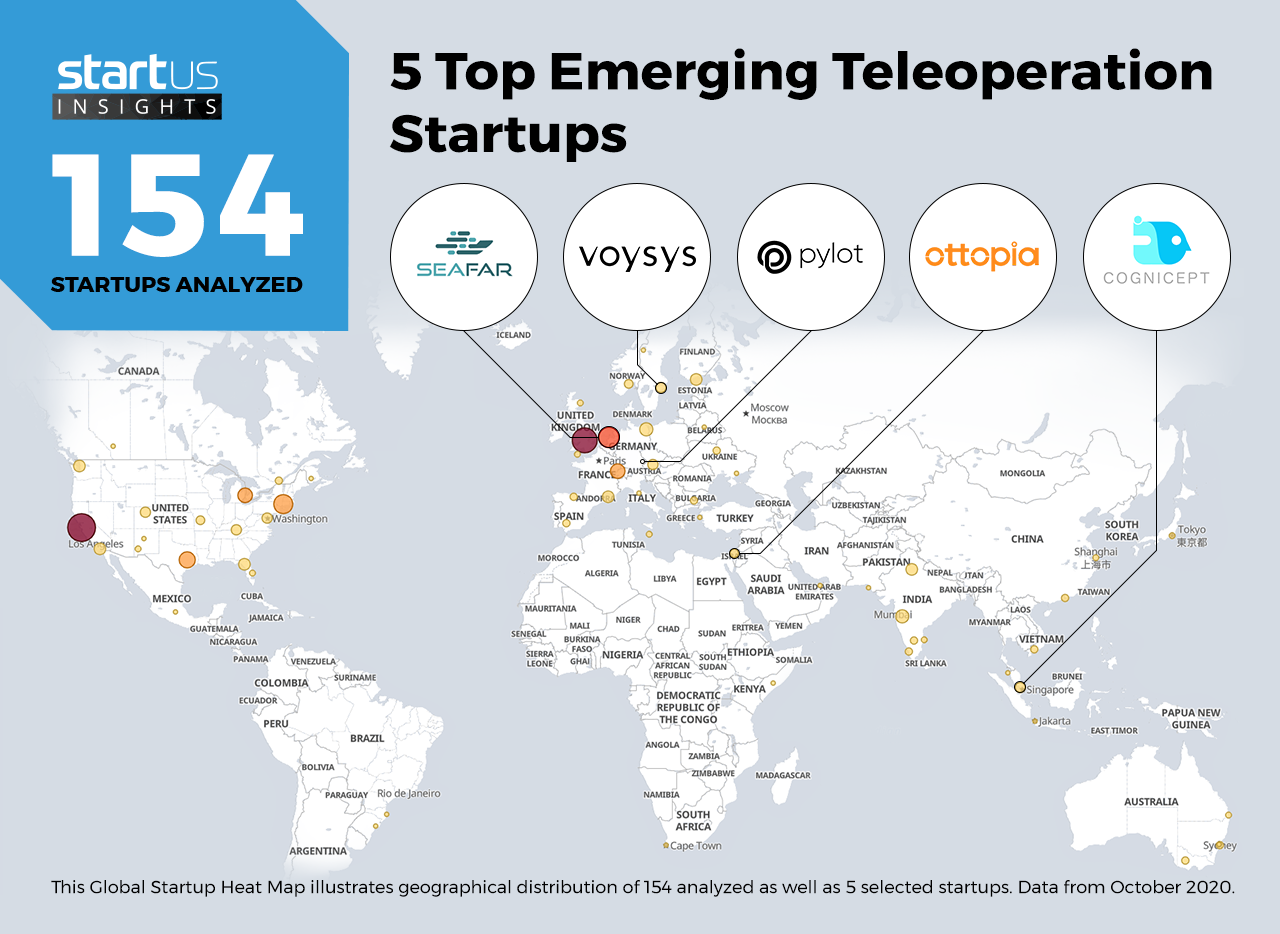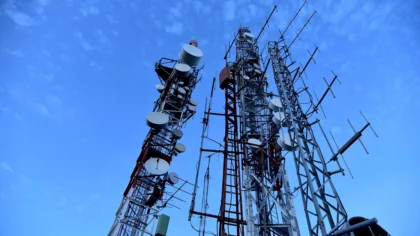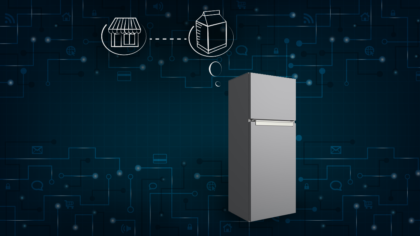Accelerate Productivity in 2025
Reignite Growth Despite the Global Slowdown
Our Innovation Analysts recently looked into emerging technologies and up-and-coming startups working on solutions for Industry 4.0. As there is a large number of startups working on a wide variety of solutions, we decided to share our insights with you. This time, we are taking a look at 5 promising teleoperation startups.
Heat Map: 5 Top Emerging Teleoperations Startups
Using our StartUs Insights Discovery Platform, covering 1.379.000+ startups & scaleups globally, we looked at innovation in the field of Industry 4.0. For this research, we identified 154 relevant solutions and picked 5 to showcase below. These companies were chosen based on a data-driven startup scouting approach, taking into account factors such as location, founding year, and relevance of technology, among others. Depending on your specific criteria, the top picks might look entirely different.
The Global Startup Heat Map below highlights 5 startups & scaleups developing teleoperation solutions. Moreover, the Heat Map reveals regions that observe a high startup activity and illustrates the geographic distribution of all 154 companies we analyzed for this specific topic.
Cognicept – Teleoperations Operating System (OS)
Remote control of robots requires efficient safety protocols in case of any emergency or sudden system failure. Advanced operating systems, customized to handle large volumes of data, prove beneficial in terms of enabling teleoperations. Further, controlling robots over a long-range and with a low margin for error consumes a considerable amount of computing power. Startups are developing advanced and secure operating systems specifically for teleoperations.
Singaporean startup Cognicept develops a human-robot interaction operating system. The operating system includes software modules that help remotely access and guide robot fleets. It highlights robots in need of human assistance and also facilitates quick troubleshooting. Cognicept additionally uses integrated communications to pass on the information to the right person at the right time.
Pylot – Autonomous Vehicle (AV) Teleoperation
Autonomous vehicles at Level 4 autonomy are capable of self-steering, self-accelerating, and self-braking. Additionally, the AV is able to monitor road conditions and respond to minor obstacles and determine lane changes. With the help of artificial intelligence (AI) and the Internet of Things (IoT) sensors, startups combine autonomous vehicles and teleoperations to create driverless mobility.
The German startup Pylot builds an autonomous vehicle teleoperation software platform. The startup uses virtual reality to provide human backup drivers a complete view of the autonomous vehicles. With the help of advanced sensors, the startup enables level 4 autonomy in vehicles.
Ottopia – Teleoperator Assistance Systems
Level 4 autonomous vehicles do not require any intervention from drivers but have the option to let drivers take control at any time. Driver-manager interaction is a major component in managing fleets of vehicles, whether it is cars, trucks, or even busses. Startups develop teleoperator assistance systems for fleets. In emergencies, these systems help the teleoperator make split-second decisions.
Israeli startup Ottopia provides an in-vehicle teleoperation module and teleoperation center. The startup uses proprietary software in the in-vehicle module, a plug-and-play solution that enables optimum network bonding to deliver real-time video compression. With the help of Advanced Teleoperations Assistance Systems (ATAS), an algorithm suite, the startup further ensures maximum safety. Ottopia also provides the hardware accompanied by specialized software to run teleoperation centers.
Voysys – Teleoperation Latency
Human-robot interactions, such as teleoperations, require a high level of bandwidth and latency. Complex tasks such as handling multiple robots involve the exchange of an extensive amount of information between the operator and the robots. Any instability in the bandwidth and latency risks losing control of the robots. To this end, startups are developing solutions that use existing communication networks for real-time information sharing in real-time.
Swedish startup Voysys develops video communication links for teleoperations over the fourth-generation and long-term evolution (4G/LTE) networks. Voysys supports multiple links for bandwidth boosting and latency peak mitigation. Additionally, the startup uses a super-fast congestion control algorithm to reduce any unnecessary teleoperation latency peaks. The smart video packaging allows the startup to minimize the video area crucial to the operator at any given moment. The low-latency 3D engine uses an advanced calibration algorithm to render objects in the right direction and assist the operators with the Natural Field of View, enabling an increase in speed assessment.
SEAFAR – Remote Ship Management
Shipping vessels require a crew, supplies, and fuel to transport cargo and people to different destinations in the world. Advanced teleoperation solutions enable shipping companies to operate a fleet of semi-autonomous ships. Autonomous ships also effectively utilize the available space. Startups and scaleups develop artificial intelligence (AI)-enabled teleoperation solutions for remote ship management.
Belgian startup SEAFAR offers teleoperation products for uncrewed and reduced crew vessels. The startup uses multiple types of exteroceptive sensors to incorporate artificial intelligence algorithms for sensor fusion and build an accurate model of the environment. SEAFAR uses sensors such as LiDAR, radar, and cameras to produce data to solve problems of obstacle identification and classification. With the help of licensed captains, the startup operates fleets from a Shore Control Center.
What About The Other 149 Solutions?
While we believe data is key to creating insights it can be easy to be overwhelmed by it. Our ambition is to create a comprehensive overview and provide actionable innovation intelligence and enable you to achieve your goals faster. The 5 teleoperation startups showcased above are promising examples out of 154 we analyzed for this article. To identify the most relevant solutions based on your specific criteria, get in touch.


![10 Top Digital Twin Startups and Companies for Industry 4.0 [2025]](https://www.startus-insights.com/wp-content/uploads/2025/06/Digital-Twin-Startups-for-Industry-4.0-SharedImg-StartUs-Insights-noresize-420x236.webp)





